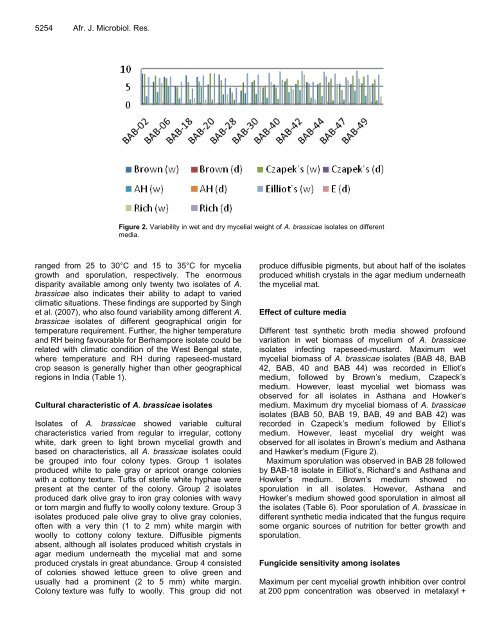Microbiology Research - Academic Journals
Microbiology Research - Academic Journals
Microbiology Research - Academic Journals
You also want an ePaper? Increase the reach of your titles
YUMPU automatically turns print PDFs into web optimized ePapers that Google loves.
5254 Afr. J. Microbiol. Res.<br />
Figure 2. Variability in wet and dry mycelial weight of A. brassicae isolates on different<br />
media.<br />
ranged from 25 to 30°C and 15 to 35°C for mycelia<br />
growth and sporulation, respectively. The enormous<br />
disparity available among only twenty two isolates of A.<br />
brassicae also indicates their ability to adapt to varied<br />
climatic situations. These findings are supported by Singh<br />
et al. (2007), who also found variability among different A.<br />
brassicae isolates of different geographical origin for<br />
temperature requirement. Further, the higher temperature<br />
and RH being favourable for Berhampore isolate could be<br />
related with climatic condition of the West Bengal state,<br />
where temperature and RH during rapeseed-mustard<br />
crop season is generally higher than other geographical<br />
regions in India (Table 1).<br />
Cultural characteristic of A. brassicae isolates<br />
Isolates of A. brassicae showed variable cultural<br />
characteristics varied from regular to irregular, cottony<br />
white, dark green to light brown mycelial growth and<br />
based on characteristics, all A. brassicae isolates could<br />
be grouped into four colony types. Group 1 isolates<br />
produced white to pale gray or apricot orange colonies<br />
with a cottony texture. Tufts of sterile white hyphae were<br />
present at the center of the colony. Group 2 isolates<br />
produced dark olive gray to iron gray colonies with wavy<br />
or torn margin and fluffy to woolly colony texture. Group 3<br />
isolates produced pale olive gray to olive gray colonies,<br />
often with a very thin (1 to 2 mm) white margin with<br />
woolly to cottony colony texture. Diffusible pigments<br />
absent, although all isolates produced whitish crystals in<br />
agar medium underneath the mycelial mat and some<br />
produced crystals in great abundance. Group 4 consisted<br />
of colonies showed lettuce green to olive green and<br />
usually had a prominent (2 to 5 mm) white margin.<br />
Colony texture was fulfy to woolly. This group did not<br />
produce diffusible pigments, but about half of the isolates<br />
produced whitish crystals in the agar medium underneath<br />
the mycelial mat.<br />
Effect of culture media<br />
Different test synthetic broth media showed profound<br />
variation in wet biomass of mycelium of A. brassicae<br />
isolates infecting rapeseed-mustard. Maximum wet<br />
mycelial biomass of A. brassicae isolates (BAB 48, BAB<br />
42, BAB, 40 and BAB 44) was recorded in Elliot‟s<br />
medium, followed by Brown‟s medium, Czapeck‟s<br />
medium. However, least mycelial wet biomass was<br />
observed for all isolates in Asthana and Howker‟s<br />
medium. Maximum dry mycelial biomass of A. brassicae<br />
isolates (BAB 50, BAB 19, BAB, 49 and BAB 42) was<br />
recorded in Czapeck‟s medium followed by Elliot‟s<br />
medium. However, least mycelial dry weight was<br />
observed for all isolates in Brown‟s medium and Asthana<br />
and Hawker‟s medium (Figure 2).<br />
Maximum sporulation was observed in BAB 28 followed<br />
by BAB-18 isolate in Eilliot‟s, Richard‟s and Asthana and<br />
Howker‟s medium. Brown‟s medium showed no<br />
sporulation in all isolates. However, Asthana and<br />
Howker‟s medium showed good sporulation in almost all<br />
the isolates (Table 6). Poor sporulation of A. brassicae in<br />
different synthetic media indicated that the fungus require<br />
some organic sources of nutrition for better growth and<br />
sporulation.<br />
Fungicide sensitivity among isolates<br />
Maximum per cent mycelial growth inhibition over control<br />
at 200 ppm concentration was observed in metalaxyl +

















